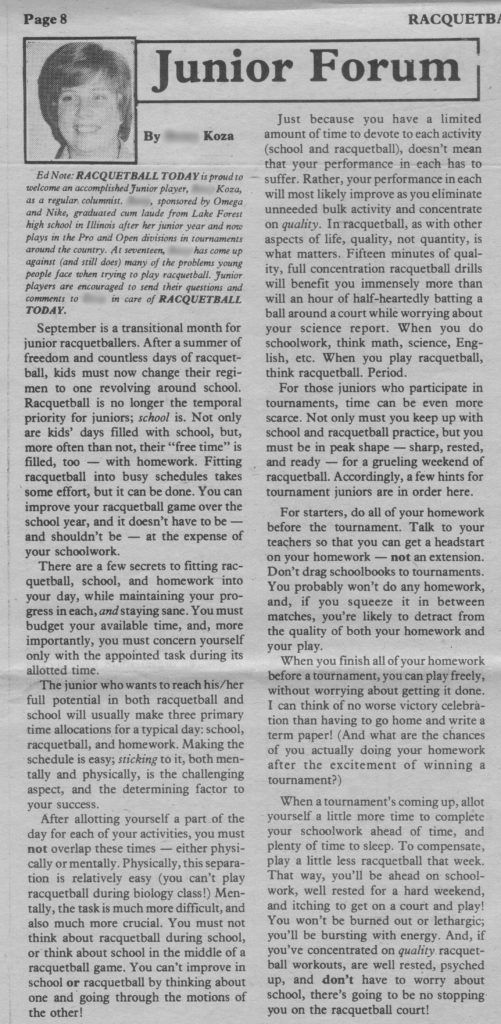From Kelly Manjula Koza’s archives: A scan of a piece I wrote for my first real job as a columnist for a national sports publication in the early 1980’s.
A month or so before I graduated high school, I was asked to write a regular column for a regional sports publication that was launching nationally. My only directive was that the column was to be “for junior athletes”. I accepted the offer, mused a bit, and a few weeks later, I sent in my first column — which I had typed on correctable paper using a mechanical typewriter and mailed in a stamped envelope. It was 1980, before personal computers, email, faxes, or cell phones!
A day later I received a call: The publisher wanted to know if I would be available to edit the entire paper, and yes, I would be paid for that as well as my column. After several days of contemplating this additional job offer — a little mind-blowing for a 16-year old kid who already felt in over her head as a “pro athlete”— I decided that the few days a week of driving nearly 60 miles across the metropolis to the newspaper office was not practical.
Instead, I wrote more for the paper. Lots more. Over the course of two or three years, in addition to my monthly column, I penned so many player profiles, tournament recaps, and other features (and contributed a few not-so-good photos) that I soon insisted the publisher not put my by-line on anything except my column. (I also edited, laid out, and ghost wrote columns for a few initial newsletters for the fledgeling women’s pro association, which started without staff and was run by collective volunteer effort at first.)
Of the dozens of pieces published, I kept only the random column shown below and one feature. I don’t tend to save things, especially my own work, and in the years before scans were easy and photos were digital, I discarded almost all articles I had written that were published in newsprint, and did so without saving a copy. At times I wish I had saved more, as it would be interesting now to read what I had written then!
I do recall that the first column (which is not the one below) stated my ideal for the series: To inspire kids (and adults) to improve themselves, their physical and mental health and well-being, their playing ability, their love of sports, and their lives in general — and to play and live fairly and honestly. I was rather surprised at the number of adults who confided to me that my column was their favorite part of the paper.
And yes, the first name in the byline and intro paragraph below is blurred, as at that time I was called by a variation of the first name I was given at birth. The given name most definitely did not suit me and the nickname did not either. I legally changed my name some years later.
(Text continues after the article)

Writing for RT was actually my second job in journalism. My first was unpaid, when I started writing for my high school newspaper for typical reason: The paper didn’t cover girls’ sports. When the LFHS girls’ field hockey team won the state title (again), not one single paragraph about the championship girls’ team appeared in the paper. I and most girls in the school were incensed at the omission, so I penned a letter to the paper’s editor and faculty advisor. The editor responded that there were not enough reporters (all guys) to cover the girls’ sports. I wanted to write articles about girls’ sports, the paper would publish them.
Of course I wrote articles — quite a few, as I recall – and by default, I became the paper’s girl’s sports editor. Along with the rest of the paper’s staff, I attended journalism workshops given by a senior editor from the Chicago Tribune, which I found both interesting and helpful. Years later, I also laughed at an irony that evolved: The editor of the school paper who told me I had to pen articles about girls’ sports if I wanted any in the high school paper later became a sports editor and a senior editor of the Tribune.
I would suspect that the Tribune, like most mainstream media, does need more reporters to cover women’s sports. If I recall my figures correctly, only 4% of media sports coverage is devoted to women’s sports. While viewership for women’s sports has increased tremendously, and prize money for some sports has increased to some degree, media coverage still lags.
